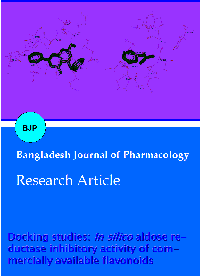Docking studies: In silico aldose reductase inhibitory activity of commercially available flavonoids
DOI:
https://doi.org/10.3329/bjp.v7i2.10779Keywords:
Flavonoids, Binding energy, Inhibition constant, Intermolecular energy.Abstract
New drugs for the inhibition of the enzyme aldose reductase are in development and they have to be screened before being considered for preclinical and clinical evaluation. The current study deals with the evaluation of the cyclooxygenase inhibitory activity of flavonoids using in silico docking studies. In this perspective, flavonoids like bergapten, buceracidin-B, dorsilurin-F, communin-A, and coumestrol were selected. Epalrestat, a known aldose reductase inhibitor was used as the standard. Docking results showed that all the selected flavonoids showed binding energy ranging between -7.91 kcal/mol to -5.08 kcal/mol when compared with that of the standard (-5.59 kcal/mol). Intermolecular energy (-9.11 kcal/mol to -8.66 kcal/mol) and inhibition constant (1.58 µM to 187.37 µM) of the ligands also coincide with the binding energy. Communin-A contributed better aldose reductase inhibitory activity because of its structural parameters.
Downloads
471
340 Read
57
References
Azam F, Prasad MVV, Thangavel N. Molecular docking studies of 1-(substituted phenyl) -3- (naphtha [1,2 d] thiazol -2-yl) urea/thiourea derivatives with human adenosine A2A receptor. Bioinformation 2011; 6: 330-34.
Dias R, Azevedo WF. Molecular docking algorithms. Curr Drug Targets. 2008; 9: 1040-47.
Dong Y, Yang J, Ren X, Zhang H, He J. New Aldose Reductase Inhibitors N99-596 A and B from Streptomyces. J Antibiotics. 2005; 58: 737-39.
Goodsell DS, Morris GM, Olson AJ. Automated docking of flexible ligands: Applications of Autodock. J Mol Recog. 1996; 9: 1-5.
Guzman A, Guerrero OR. Inhibition of aldose reductase by herbs extracts and natural substances and their role in prevention of cataracts. Revista Cubana de Plantas Medicinales. 2005; 10: 3-4.
Hetenyi C, Van der Spoel D. Efficient docking of peptides to proteins without prior knowledge of the binding site. Protein Sci. 2002; 11: 1729-37.
Hwang YC, Shaw S, Kaneko M. Aldose reductase pathway mediates JAK-STAT signaling: a novel axis in myocardial ischemic injury. J Fed Am Soci Exp Biol. 2005; 19: 795-97.
Konc J, Konc JT, Penca M, Janezic D. Binding-sites prediction assisting protein-protein docking. Acta Chim. Slov. 2011; 58: 396401.
Madeswaran A, Umamaheswari M, Asokkumar K, Sivashanmugam T, Subhadradevi V, Jagannath P. In Silico docking studies of lipoxygenase inhibitory activity of commercially available flavonoids J Comput Method Mol Design. 2011; 1: 65-72.
Madeswaran A, Umamaheswari M, Asokkumar K, Sivashanmugam T, Subhadradevi V, Jagannath P. In silico docking studies of lipoxygenase inhibitory activity of commercially available flavonoids. Orient Pharm Exp Med 2012; 12: 157-61.
Morris GM, Huey R, Lindstrom W, Sanner MF, Belew RK, Goodsell DS. AutoDock4 and AutoDockTools4: Automated docking with selective receptor flexibility. J. Computational Chem. 2009; 30: 2785-91.
Patel JM . A review of potential health benefits of flavonoids. Lethbridge Undergraduate Res J. 2008; 3: 1-5.
Ravindranath TM, Mong PY, Ananthakrishnan R. Novel role for aldose reductase in mediating acute inflammatory responses in the lung. J Immunol. 2009; 183: 8128-37.
Saraswat M, Muthenna P, Suryanarayana P, Petrash JM, Reddy G. Dietary sources of aldose reductase inhibitors: Prospects for alleviating diabetic complications. Asia Pacific J Clin Nut. 2008; 17: 558-65.
Sivakumar R, Lokesh N, Rajashekhar A, Ramu N, Saikishore P, Venkatanarayanan R. Docking studies on PPAR? of novel ?-phenoxy phenyl propionic acid derivatives as antidiabetic agent. Der Pharmacia Sinica. 2011; 2: 327.
Umamaheswari M, Madeswaran A, Asokkumar K, Sivashanmugam T, Subhadradevi V, Jagannath P. Study of potential xanthine oxidase inhibitors: In silico and in vitro biological activity. Bangladesh J Pharmacol. 2011; 6: 117-23.
Yadav UC, Naura AS, Aguilera AL. Aldose reductase inhibition suppresses the expression of Th2 cytokines and airway inflammation in ovalbumin-induced asthma in mice. J Immunol. 2009; 183: 4723-32.

Additional Files
Published
How to Cite
Issue
Section
License
Authors who publish with this journal agree to the following terms:
- Authors retain copyright and grant the journal right of first publication with the work simultaneously licensed under a Creative Commons Attribution License that allows others to share the work with an acknowledgement of the work's authorship and initial publication in this journal.
- Authors are able to enter into separate, additional contractual arrangements for the non-exclusive distribution of the journal's published version of the work (e.g., post it to an institutional repository or publish it in a book), with an acknowledgement of its initial publication in this journal.
- Authors are permitted and encouraged to post their work online (e.g., in institutional repositories or on their website) prior to and during the submission process, as it can lead to productive exchanges, as well as earlier and greater citation of published work (See The Effect of Open Access).
